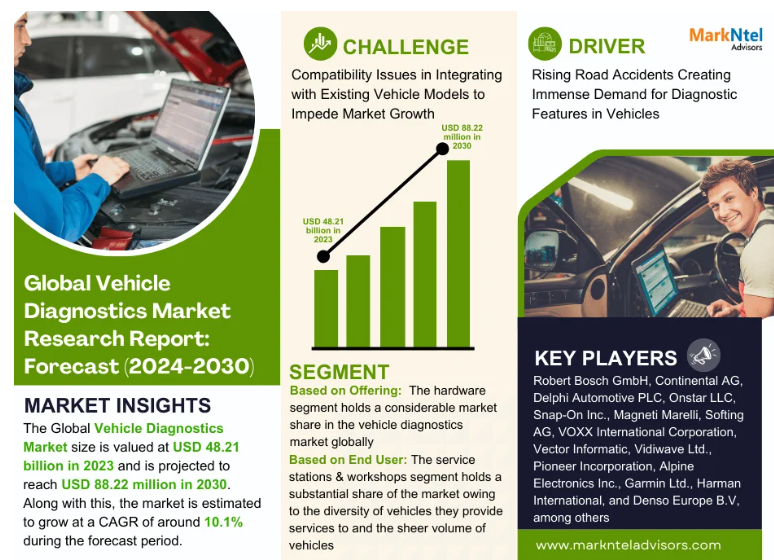
News, 28th October 2024
Market definition
Using specialized equipment and software, automotive diagnostics involves identifying, evaluating, and diagnosing any issues with a car. Through an on-board diagnostic connection, the car diagnostic systems are able to enter the computer of a vehicle, read data from the system, and use that information to identify and track down issues and malfunctions. Such information could include how the vehicle’s engine, gearbox, brakes, etc. operate.
Global Vehicle Diagnostics Market Insights & Analysis (2024-30):
The size of the global vehicle diagnostics market is expected to grow from its 2023 valuation of USD 48.21 billion to USD 88.22 billion by 2030. Additionally, during the course of the projected period, the market is anticipated to expand at a CAGR of about 10.1%. The modern cars, with their increasingly complex electronics, sensors, and software, are responsible for this market expansion. Advanced driver-assistance systems (ADAS) , autonomous driving technologies, entertainment systems, and electric powertrains are just a few examples of the complex electronic systems found in modern automobiles, buses, lorries, and other vehicle.
To ensure that every system operates at peak efficiency, such systems require increasingly advanced and precise diagnostic tools. For safety and dependability, features like adaptive cruise control, lane-keeping assistance, and ADAS collision avoidance systems need constant monitoring and troubleshooting. As cars get more sophisticated, there is a greater need for software and diagnostic tools to properly maintain and monitor these systems, which is driving market expansion.
Period of study: Data: 2019-22
( 2023)Market Value :48.21 Billion USD
(2030) Market value: 88.22 Billion
Furthermore, the global car industry is shifting toward electric and hybrid vehicles due to stricter emission regulations and growing environmental concerns. Governments all around the world have created laws and financial incentives to reduce carbon emissions, which has caused automakers to speed up the development and production of EVs and hybrid vehicles. This trend has also been accelerated by rising consumer awareness of and demand for cleaner transportation, as well as advancements in battery technology that have increased EVs’ performance, price, and range. For example,
The International Energy Administration estimates that China registered over 8.1 million new electric vehicles in 2023, a 35% increase over 2022.
With the increasing number of electric and hybrid vehicles on the market, a variety of complications have been added. High-voltage batteries, electric motors, power electronics, and regenerative braking are some of the cutting-edge technologies found in these cars; each one calls for specially designed and highly complex diagnostic techniques. Furthermore, diagnostic tools that can download, analyze, and update software are necessary for the intricate software and control systems found in EVs and hybrids. Consequently, there has been a significant global need for car diagnostics systems and solutions. As the demand for electric and hybrid vehicles rises and vehicle complexity increases, the vehicle diagnostic market is expanding at an incredible rate, which supports the expansion of the global vehicle diagnostic.
Global Vehicle Diagnostics Market Driver:
An increase in traffic accidents generating a huge demand for car diagnostic features Vehicle ownership and traffic density have been rising globally due to rapid urbanization and road network growth. The risk of accidents is also rising as a result of more vehicles on the road, particularly in emerging nations where infrastructure improvement typically does not keep pace with traffic growth. Inadequate vehicle maintenance and servicing also contribute to incidents like airbag failures, system crashes, and brake failures. Around the world, this has led to serious traffic accidents and fatalities. For example,
The World Health Organization (WHO) estimates that 1.19 million people died worldwide each year as a result of traffic accidents in 2023.
Regular diagnostics are performed to identify potential failures of vital parts such as the tires, steering, and brakes in order to lessen these circumstances, which increases the need for vehicle diagnostic systems. The likelihood of an accident occurring as a result of mechanical breakdown is significantly decreased by this proactive approach to vehicle maintenance. Additionally, real-time monitoring and diagnostics are made possible by the integration of telematics and linked vehicle technologies in vehicle diagnostics systems. This allows fleet operators and individual drivers to receive real-time notifications on upcoming safety hazards. In addition to preventing accidents, this aids in post-accident investigation by offering valuable data for raising vehicle safety and design standards. Therefore, an increase in traffic accidents necessitates the use of car diagnostics, which in turn fuels the expansion of.
Opportunity for the Global Vehicle Diagnostics Market:
Vehicle Diagnostic Systems’ Integration of AI and Machine Learning to Drive Market Growth AI is becoming more and more integrated with vehicle diagnostics as a result of the complexity of today’s cars, which contain cutting-edge systems like ADAS, electric powertrains, and linked technologies. AI makes it possible to analyze large amounts of data from sensors and ECUs (Electric Control Units) in real time, which enhances fault detection and, as a result, helps to anticipate problems before they arise. As a result, vehicles may be maintained more effectively, have less downtime, and be safer. Additionally, AI tailors diagnostics based on driving habits to guarantee peak performance. These days, as these cars become more efficient, AI-driven diagnostics play a significant role in managing and maintaining them to keep these systems operating dependably and efficiently. As a result, businesses like V2M.
Additionally, AI makes it simple to create user-friendly diagnostic tool interfaces, such as mobile apps that give drivers real-time vehicle health updates and alarms, further enabling advanced diagnostics for regular drivers. AI in vehicle diagnostics will drive the next generation of intelligent, dependable, and economical automobiles, creating enormous prospects in the global vehicle diagnostics market as the automotive industry continues to innovate.
Challenge of the Global Vehicle Diagnostics Market:
Problems Integrating with Current Vehicle Models to Prevent Market Growth The diagnostic system’s incompatibility with older car models is a significant obstacle to the global expansion of the automotive diagnostics market. The automobile industry is still developing at a very rapid rate, with vehicles being designed using a wide range of electronic systems, sensors, and software from various manufacturers, models, and production years. Because of this, the environment becomes so complicated that it is impossible to construct a single diagnostic instrument that would operate with every car. Integration with sophisticated vehicle diagnostic systems is hampered by the fact that the majority of older cars lack the standard OBD-II connections. Additionally, the majority of them lack the electronic design necessary to allow contemporary diagnostics without the need for outdated or specialist gear. Because of this, it is extremely challenging for a service provider to establish an accurate diagnosis.
Additionally, automakers frequently incorporate proprietary software and communication protocols into the construction of their vehicles, which makes diagnosis more difficult. In order to prohibit independent repair shops or any aftermarket service provider from doing comprehensive diagnostics, these systems are frequently proprietary and require specialized tools that are incompatible with third-party diagnostic tools. These compatibility problems hinder the growth of the car diagnosis market globally and have an impact on the aftermarket. In order to cover a wide range of cars, it forces service providers to make investments in several equipment and software upgrades. This hinders the growth of the global vehicle diagnostics market overall by raising expenses and complicating the diagnostic procedure.
Segmentation Analysis of the Global Vehicle Diagnostics Market (2024–30)
In addition to evaluating and highlighting the key trends and contributing variables in each category, MarkNtel Advisors’ Global Vehicle Diagnostics Market analysis also offers projections for the global market from 2023 to 2030. The market has been further divided into the following categories based on the analysis:
Depending on the Offering: Hardware
Tools for Diagnosis
Portable Electronics
Other Connectors & Adapters (Battery Analyzers, Testers, etc.)
Programs
In the worldwide automotive diagnostics market, the hardware category has a larger market share than the other one. The need for diagnostic tools and hardware, like code readers, handhelds, and scan tools, to interact directly with the car’s onboard diagnostics system is driving up demand for and acceptance of these devices. These equipment are essential for experts and repair shops alike since they provide fast, precise data on vehicle performance. Modern cars, especially those with electric powertrains or sophisticated driver-assistance systems, require specialized diagnostic equipment to handle issues. This increases hardware adoption by creating a need for highly specialized instruments, like oscilloscopes and engine analyzers, to identify issues in complex systems that need in-depth examination. The need for hardware components is further increased by the fact that connectors and adapters are equally crucial in guaranteeing interoperability between diagnostic instruments and different vehicle interfaces.
As a result, one of the essential components of the car diagnostic systems is hardware. With the rise of cloud-based diagnostics and remote vehicle monitoring, software and services are equally vital, but they require robust hardware to function, which contributes to the expansion of the hardware segment in the global car diagnostic market.
According to End User: Workshops & Service Stations for Auto OEMs
Operators of Fleets
Regulatory and Governmental Organizations
In comparison to OEMs and fleet operators, the service stations and workshops segment has a significant market share based on end users because of the variety of cars they service and the sheer number of vehicles they handle. There is an enormous variety of cars from different brands at the service stations and workshops. Because of this, they offer a variety of diagnostic equipment that are appropriate for various car models and types, which increases demand for and use of them in service centers. Additionally, because service centers and workshops provide services to a wide range of customers, they must make significant investments in cutting-edge diagnostic equipment, which boosts their uptake.
Additionally, the majority of the fleet in North America and Europe is made up of older cars that are kept in operation for longer periods of time, which raises the need for diagnostics in shops and service stations. Customers place a great value on accurate diagnostics in older vehicles. Because older cars require more frequent maintenance and repairs, spotting potential issues early on can help prevent costly breakdowns. These services are primarily offered by independent workshops and service stations, and they are more prevalent in older vehicles that are not covered by warranties or OEM station repair programs, which encourage the use of diagnostic tools in service centers and drive market expansion.
Regional Forecast for the Global Vehicle Diagnostics Market (2024–30)
The global market for vehicle diagnostics is expanding geographically across:
North America
Europe and South America
Africa and the Middle East
Asia-Pacific
Throughout the projected period, Europe is expected to hold the greatest market share and dominate the others. Any car must have the newest OBDs installed because to the stringent safety and pollution rules set by European authorities. For example, EU Euro 6 regulations necessitate full emissions monitoring; consequently, advanced diagnostic techniques are essential to meeting this compliance requirement. Diagnostic tools that precisely track and report on emissions and vehicle performance are in high demand as a result.
Furthermore, Europe is home to the bulk of top automakers and tier-one suppliers, like Daimler, BMW, Volkswagen, and others. These kinds of businesses are inherently drawn to cutting-edge automotive technologies and, consequently, diagnostic systems. These major automakers fuel the need for cutting-edge diagnostics that can accommodate new car models and technologies, especially e-mobility and hybrid drivetrains that need for specific diagnostic equipment.
High levels of technical adoption and a heavy emphasis on vehicle maintenance and safety are further characteristics of the European market. As a result, fleet managers and consumers in Europe are requesting more sophisticated diagnostic tools that would enhance vehicle performance monitoring, provide real-time data, and enable predictive maintenance. Well-constructed infrastructure support for vehicle repair and maintenance throughout the region, including a network of authorized service centers and independent workshops equipped with cutting-edge diagnostic equipment, further increases this demand and propels Europe’s rise in the global vehicle diagnostics market.
Recent Developments in the Global Vehicle Diagnostics Industry:
In 2023, the Bosch Car Doctor, a portable diagnostic device with sophisticated scanning capabilities and real-time data analysis functions, was unveiled by Robert Bosch GmbH, a prominent supplier of automotive technology.
In order to enable workshops access industry-leading diagnostic solutions and improve the quality of their repairs, Delphi Automotive PLC introduced a new online configurator for their diagnostic products and related accessories in 2023
Use Our Global Vehicle Diagnostics Market Report to Get a Competitive Advantage
The MarkNtel Advisors Global Vehicle Diagnostics Market Report offers a comprehensive and in-depth examination of the market’s size and share, growth rate, competitive environment, and major players. Businesses may better grasp market dynamics and make wise decisions with the aid of this thorough analysis.
Additionally, by highlighting current market trends and future estimates, this research helps firms recognize new opportunities as well as possible obstacles. Businesses can synchronize their plans and maintain a competitive edge by comprehending market forecasts.
The Global Vehicle Diagnostics Market Report helps evaluate and reduce the risks of entering or participating in the market. Businesses can create plans to reduce risks and improve operations by comprehending market dynamics, legal frameworks, and possible obstacles.



